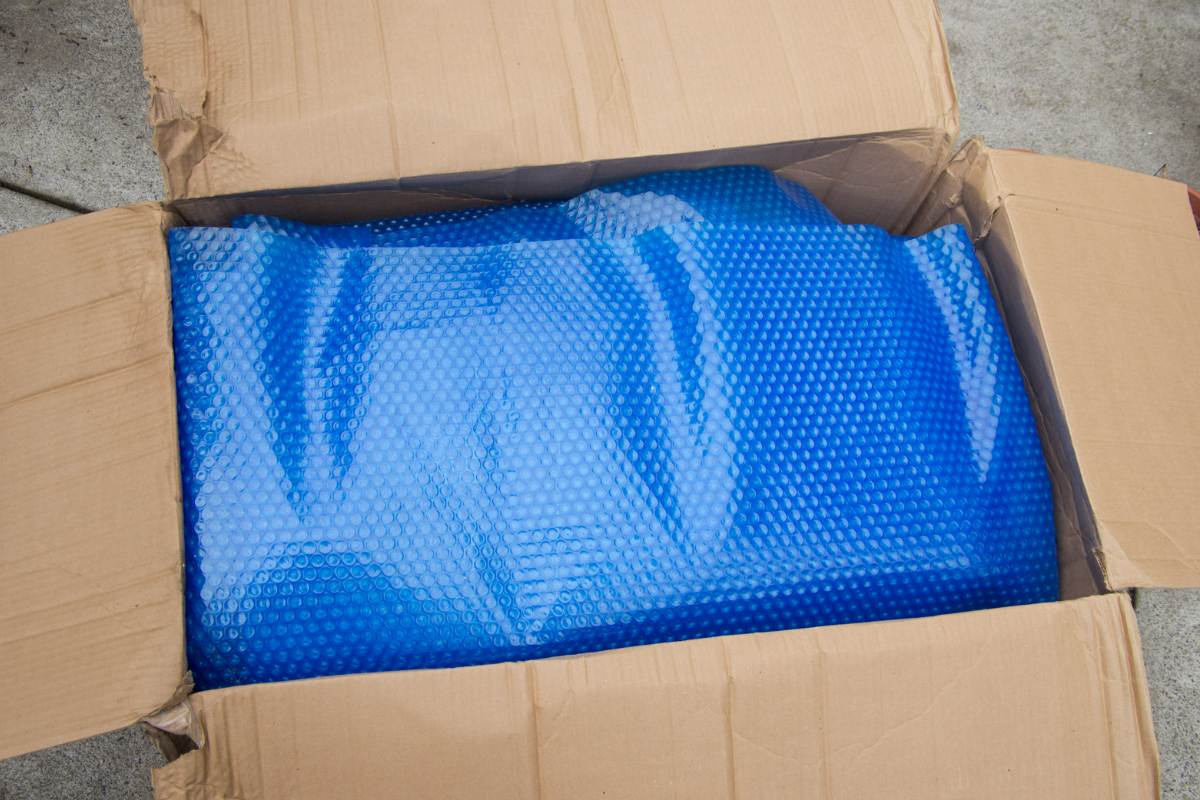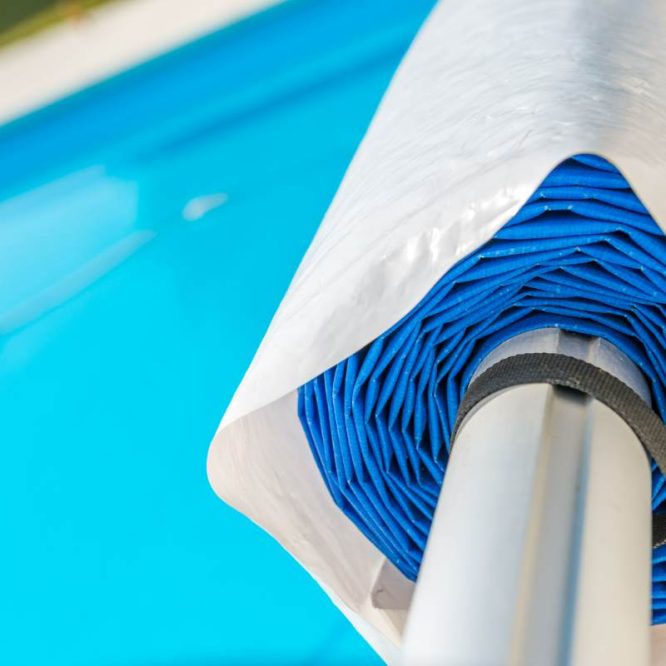Solar pool covers come in various thickness measurements, but the best solar pool cover thickness for your swimming pool is 12 ml. The solar pool cover serves an important function: protecting the swimming pool. This entails covering the swimming pool to prevent debris from entering the pool water, preventing the evaporation of the pool chemicals, and keeping the pool temperature within the desired range by preventing heat loss. You should buy the best solar pool cover for your pool, which can be achieved by reading on to learn more about solar pool cover thickness and other essential elements.
How Solar Pool Cover Functions?
The solar pool cover has air bubbles on one side, and this side covers the swimming pool. When the sun is out, this pool cover receives the heat from the sun’s rays and transfers this heat to air bubbles. Ultimately, this heat is now channeled to the pool water via conduction.
Aside from heating the pool, it also improves the pool’s heat retention, especially during cold nights when the pool water usually loses a lot of surface heat. The pool cover prolongs the effectiveness of the chemicals in the pool and mitigates the chemical degradation effect of UV rays from the sun.
Its Thickness Dimensions
A pool owner may ask, “Does it matter how thick my solar pool cover is?” Yes, it does. As we mentioned earlier, solar pool covers have different thickness dimensions, and their performances also differ. These dimensions include 8 ml, 12 ml, and 16 ml. The thinner the solar blanket, the more of the sun’s heat it will allow to pass through it. This means an 8 ml solar cover will perform better than a 12 ml or 16 ml solar cover in the amount of direct sunlight it allows to go through it and heat the water.
On the flip side, the thicker the solar cover, the greater its ability to retain heat. So, a 16 ml solar pool cover will have a better heat retention capacity than an 8 ml or 12 ml solar blanket. In summary, thicker solar covers are better at retaining heat, while thinner solar pool covers are better at heat transfer.

Colors
Does color matter when it comes to solar covers? Yes. Just as certain colors absorb more heat from the sun and some colors absorb less heat, that’s how it works with solar covers. There are several colors of solar blankets, including dark blue, light blue, clear, grey, or silver, etc. Let’s talk about some colors and how they function in heat retention and transference.
Light Blue Solar Pool Cover
This solar pool cover color is great at trapping the heat from the sun’s rays, and it’s also effective at blocking the UV rays of the sun from gaining access to the pool and depleting the chemicals in the pool. However, there are downsides to the light blue color. It blocks a great amount of heat from entering the swimming pool. According to the American Department of Energy, opaque solar covers block almost double the amount of heat that clear solar covers block. It’s midway in terms of retaining heat and gaining heat compared to other colors, but it’s the most widely used.
Dark Blue Solar Pool Cover
When it comes to retaining heat, no other color does it better than dark blue, and though it absorbs a good amount of solar heat, it doesn’t topple clear solar covers in letting heat pass through to the pool water. Still, this color is the best choice if you only intend to cover the pool at night because it will keep your pool warm till the following day.
Clear/translucent Pool Solar Cover
A clear cover is the best pool solar cover when it comes to letting heat pass through the cover to the pool. It achieves a higher net heat gain than other colors. However, with the clear solar cover, it loses heat as easily as it gains. It’s the worst pool solar cover for a chlorine-treated pool because it’s incapable of effectively blocking UV light, and this will result in chemical depletion.
Pros of a Thicker Cover
- It retains solar cover heat better, keeping the water temperature warm for longer.
- It’s more durable.
- It’s more effective in blocking UV rays which degrades pool chemicals. This means that with this pool solar cover, you’ll use fewer chemicals in your pool.
- It reduces the rate at which the water evaporates.
- It’s more resilient against falling branches or sticks.
- It keeps the pool debris-free.
Cons of a Thicker Cover
- They’re more expensive.
- They’re heavier, so they are more stressful to uncover and store.
Pros of a Thinner Cover
- They’re lighter in weight.
- They’re very effective in allowing heat from the sun to pass through them and are excellent in transferring heat.
- Just like thicker covers, it keeps the pool clean and reduces evaporation.
- It’s more affordable.
- They’re easier to uncover and store.
Cons of a Thinner Cover
- This pool cover is less durable than a thicker pool cover.
- A thinner solar cover is less effective than thicker covers in retaining solar heating.
How Long Do Pool Solar Covers Last?
The durability of a pool solar cover depends on the chlorine level of the pool, the amount of sun exposure it gets, and the pH levels of the pool water. To make your pool solar cover last longer, we recommend avoiding using it on the pool shortly after shocking the pool (applying chlorine to prevent the growth of algae) or when the pool’s chlorine level is above 2.5 ppm. This is because high chlorine levels and high acidic levels (low pH) gradually eat at the solar pool cover.
How you store your solar pool covers also matters because covering them when not in use and keeping them in the shade makes them last longer. On the other hand, when you fold and leave them out in the open or when it’s rolled on a solar reel, the UV radiation from the sun will affect the plastic bubbles and gradually destroy them.
In summary, if you take all the necessary precautionary measures for your solar cover, it should last for 5-7 years. However, in very hot regions where the solar cover is frequently exposed to intense sunlight for at least 6 hours every day, the solar cover won’t exceed four years regardless of the care it gets from the pool owners.
The Upsides of Using a Solar Cover
Save Money on Energy Bills
The most important benefit of using solar pool covers is that you’ll save significant money on heating costs. Imagine you had to install pool heating equipment and the spike it will cause in your energy bills. Solar pool covers eliminate the need for such equipment, and the best thing is that these solar covers don’t require electricity to work. They just need solar energy. The more sunlight hours you get in your area, the more heat the pool covers get, and the more effective these solar covers will be in increasing the pool temperature
Reduces Chemical Evaporation
Using the solar pool cover prevents most of the chemicals you apply in the pool from evaporating. This, in turn, leads to fewer expenses on pool chemicals since they last longer in the pool
They Keep the Pool Warm
Solar pool covers, whether thick or thin, effectively keep the pool warm for a longer period. They ensure the pool absorbs more heat and is not too cold to swim in the following morning.
It Reduces Water Evaporation
This is one of the most eco-friendly perks pool owners can enjoy from this solar blanket. As they reduce the rate of water evaporation, they also reduce the amount of water needed to refill the pool. This saves the pool owner more water.
How to Select the Right Solar Pool Cover
It depends on your preference. When it comes to thickness, you know that thick pool covers are better at absorbing heat, while thinner covers are better at letting heat pass through to the pool. Our recommendation to many pool owners is 12 ml because it’s in between and offers equal effectiveness in heat gain and trapping heat.
When it comes to colors, you should know that clear covers are better at heat gain but not effective in stopping UV rays from entering your pool. On the other hand, colored solar pool covers are ideal if you want to save on pool chemicals and trap more heat in the pool.
Good Alternatives to Solar Pool Covers
Solar Sun Rings
If you don’t want to go for a solar pool cover, you can opt for this. They can be installed and removed separately. We recommend buying enough units to cover 70%-80% of the pool. When these rings have heated the water to the temperature range you want, you can turn the rings upside down to stop heating and prevent water and chemical evaporation.
Solar Sun Squares
These are five by five squares that can be purchased and installed individually. They generate and transfer heat from the sun to the pool. They function in a very similar way to solar sun rings.
Solar Balls
These are not common like the first two, but they can do the job too. Simply place a pierced solar ball in a skimmer basket and let it release its thermally insulating liquid all over the pool water. This liquid forms a safe and invisible barrier over the pool. This liquid can last for a month, and it has a coverage of 12,000 gallons of water, and the average pool contains between 18,000-20,000 gallons. So a pair of solar balls is all you need.

